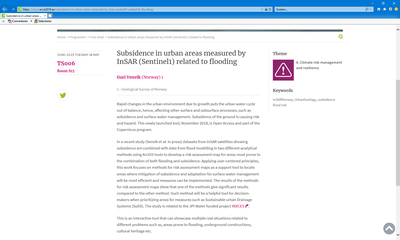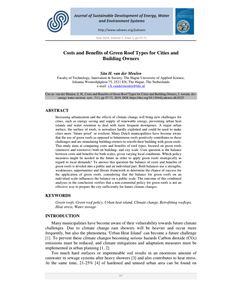This CIENS-report sums up the main findings from the project “Cultural heritage and water management in urban planning” (Urban WATCH), financed by the Research Council of Norway through the MILJØ2015 programme, and cofunded by the Directorate for Cultural Heritage in Norway (Riksantikvaren) and the Geological Survey of Norway (NGU). The project started up in 2012 and ended in 2015.
DOCUMENT

Rapid changes in the urban environment due to growth puts the urban water cycle out of balance, hence, affecting other surface and subsurface processes, such as subsidence and surface water management. Subsidence of the ground is causing risk and hazard.
IMAGE

Rapid changes in the urban environment due to growth puts the urban water cycle out of balance, hence, affecting other surface and subsurface processes, such as subsidence and surface water management.Subsidence of the ground is causing risk and hazard, as well as unexpected costs. This newly, November 2018, launched tool InSARNorge is Open Access and part of the Copernicus program.In a recent study (Venvik et al. submitted) datasets from InSAR satellites showing subsidence are combined with data from flood modelling in two different analytical methods using ArcGIS tools to develop a risk assessment map for areas most prone to the combination of both flooding and subsidence. Applying usercentred principles, this work focuses on methods for risk assessment maps as a support tool to locate areas where mitigation of subsidence and adaptation for surface water management will be most efficient and measures can be implemented. The results of the methods for risk assessment maps show that one of the methods give significant results compared to the other method. Such method will be a helpful tool for decision-makers when prioritizing areas for measures such as Sustainable urban Drainage Systems (SuDS).The study is related to the JPI Water funded project INXCES (www.inxces.eu).
DOCUMENT

Post-war urban neighbourhoods in industrialised countries have been shown to negatively affect the lifestyles of their residents due to their design. This study aims at developing an empirical procedure to select locations to be redesigned and the determinants of health at stake in these locations, with involvement of residents’ perspectives as core issue. We addressed a post-war neighbourhood in the city of Groningen, the Netherlands. We collected data from three perspectives: spatial analyses by urban designers, interviews with experts in local health and social care (n = 11) and online questionnaires filled in by residents (n = 99). These data provided input for the selection of locations to be redesigned by a multidisciplinary team (n = 16). The procedure yielded the following types of locations (and determinants): An area adjacent to a central shopping mall (social interaction, traffic safety, physical activity), a park (experiencing green, physical activity, social safety, social interaction) and a block of low-rise row houses around a public square (social safety, social interaction, traffic safety). We developed an empirical procedure for the selection of locations and determinants to be addressed, with addressing residents’ perspectives. This procedure is potentially applicable to similar neighbourhoods internationally.
DOCUMENT

from the article: Abstract Based on a review of recent literature, this paper addresses the question of how urban planners can steer urban environmental quality, given the fact that it is multidimensional in character, is assessed largely in subjective terms and varies across time. The paper explores three questions that are at the core of planning and designing cities: ‘quality of what?’, ‘quality for whom?’ and ‘quality at what time?’ and illustrates the dilemmas that urban planners face in answering these questions. The three questions provide a novel framework that offers urban planners perspectives for action in finding their way out of the dilemmas identified. Rather than further detailing the exact nature of urban quality, these perspectives call for an approach to urban planning that is integrated, participative and adaptive. ; ; sustainable urban development; trade-offs; quality dimensions
DOCUMENT

Increasing urbanization and the effects of climate change will bring new challenges for cities, such as energy saving and supply of renewable energy, preventing urban heat islands and water retention to deal with more frequent downpours. A major urban surface, the surface of roofs, is nowadays hardly exploited and could be used to make cities more ‘future proof’ or resilient. Many Dutch municipalities have become aware that the use of green roofs as opposed to bituminous roofs positively contributes to these challenges and are stimulating building-owners to retrofit their building with green roofs. This study aims at comparing costs and benefits of roof types, focused on green roofs (intensive and extensive) both on building- and city scale. Core question is the balance between costs and benefits for both scales, given varying local conditions. Which policy measures might be needed in the future in order to apply green roofs strategically in regard to local demands? To answer this question the balance of costs and benefits of green roofs is divided into a public and an individual part. Both balances use a strengths, weaknesses, opportunities and threats framework to determine the chance of success for the application of green roofs, considering that the balance for green roofs on an individual scale influences the balance on a public scale. The outcome of this combined analyses in the conclusion verifies that a responsible policy and a local approach towards green roofs is necessary to prepare the city sufficiently for future climate changes. http://dx.doi.org/10.13044/j.sdewes.d6.0225
MULTIFILE

This paper examines how a serious game approach could support a participatory planning process by bringing stakeholders together to discuss interventions that assist the development of sustainable urban tourism. A serious policy game was designed and played in six European cities by a total of 73 participants, reflecting a diverse array of tourism stakeholders. By observing in-game experiences, a pre- and post -game survey and short interviews six months after playing the game, the process and impact of the game was investigated. While it proved difficult to evaluate the value of a serious game approach, results demonstrate that enacting real-life policymaking in a serious game setting can enable stakeholders to come together, and become more aware of the issues and complexities involved with urban tourism planning. This suggests a serious game can be used to stimulate the uptake of academic insights in a playful manner. However, it should be remembered that a game is a tool and does not, in itself, lead to inclusive participatory policymaking and more sustainable urban tourism planning. Consequently, care needs to be taken to ensure inclusiveness and prevent marginalization or disempowerment both within game-design and the political formation of a wider participatory planning approach.
MULTIFILE

This paper examines a co-production arrangement between private actors, households, and community actors occurring within the framework of scheme of commercialised spring water in peri-urban Bandung, Indonesia. We argue that the provision of spring water in Ujungberung District is a form of co-production, characterised by: (1) any one, or the elements, of the service production process being shared; (2) the presence of a fundamental shift in the balance of power between the primary producers and users/communities, and (3) the existence of mutual support and relationship networks, rather than a clearly defined delineation between providers and clients. Actor contributions defined as inputs along the value chain of spring water production were examined. We describe interactions between local private actors and community members in planning, service delivery, and conflict management with respect to disruption of water supplies, free-riding behaviour, and the geographical distribution of services. This paper identifies several institutional innovations that may yield a safer and more affordable water supply and nurture equity in the sense of: (1) improved access to water for the previously unserved people by piped water and boreholes; (2) the opportunity to negotiate from below; and (3) transparency and accountability.
LINK
Limited data is available on the size of urban goods movement and its impact on numerous aspects with respect to livability such as emissions and spatial impact. The latter becomes more important in densifying cities. This makes it challenging to implement effective measures that aim to reduce the negative impact of urban good movement and to monitor their impact. Furthermore, urban goods movement is diverse and because of this a tailored approach is required to take effective measures. Minimizing the negative impact of a heavy truck in construction logistics requires a different approach than a parcel delivery van. Partly due to a lack of accurate data, this diversity is often not considered when taking measures. This study describes an approach how to use available data on urban traffic, and how to enrich these with other sources, which is used to gain insight into the decomposition (number of trips and kilometers per segment and vehicle type). The usefulness of having this insight is shown for different applications by two case studies: one to estimate the effect of a zero-emission zone in the city of Utrecht and another to estimate the logistics requirements in a car-free area development.
MULTIFILE
From the article : "Based on a review of recent literature, this paper addresses the question of how urban planners can steer urban environmental quality, given the fact that it ismultidimensional in character, is assessed largely in subjective terms and varies across time. A novel perspective of urban environmental quality is proposed, simultaneously exploring three questions that are at the core of planning and designing cities: ‘quality of what?’, ‘quality for whom?’ and ‘quality at what time?’. The dilemmas that urban planners face in answering these questions are illustrated using secondary material. This approach provides perspectives for action. Rather than further detailing the exact nature of urban quality, it calls for sustainable urban environmental quality planning that is integrated, participative and adaptive" ( wileyonlinelibrary.com ) DOI: 10.1002/eet.1759 - Preprint available for free download.
DOCUMENT
